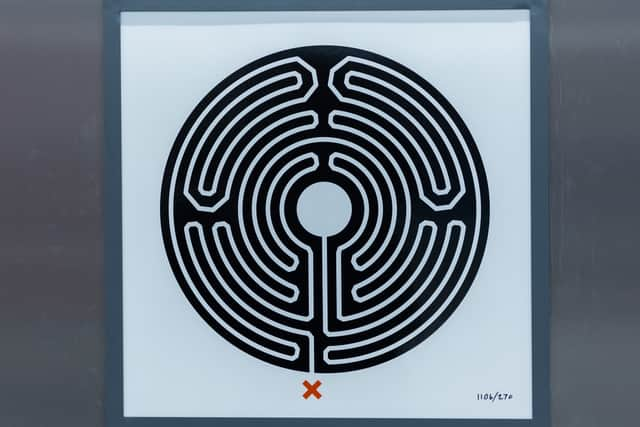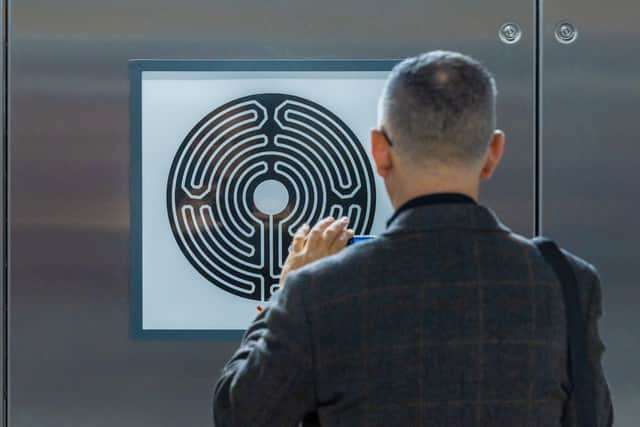TfL Tube: Why is there a 'Labyrinth' design on the wall of each London Underground station?
and live on Freeview channel 276
Well known to regular Tube travellers, the ubiquitous and highly distinct Labyrinth symbols adorn London Underground stations across the city.
Designed by award-winning artist Mark Wallinger, two new pieces have recently been unveiled at Nine Elms and Battersea, joining the 270 which have been catching commuters’ eyes for the last decade.
Advertisement
Hide AdAdvertisement
Hide AdWhile the slightly hypnotic designs may be familiar to many, what are they? And what do they show?
Mark Wallinger’s Labyrinth
Mr Wallinger’s Labyrinth was first unveiled and presented to the public in 2013, as part of Transport for London’s (TfL) Art on the Underground programme.
The work, which constituted 270 individual pieces, one for each station, was commissioned as part of a series of events celebrating the 150th anniversary of the London Underground.


According to TfL’s Art on the Underground website, Labyrinth was partially inspired by two iconic designs heavily associated with the network - the roundel and Harry Beck’s Tube map.
Advertisement
Hide AdAdvertisement
Hide AdThe entry explains of the design: “Rendered in bold black, white and red graphics, the artworks are produced in vitreous enamel, a material used for signs throughout London Underground, including the Tube’s roundel logo, whose circular nature the labyrinth design also echoes.
“Positioned at the entrance of each labyrinth is a red X. This simple mark, drawing on the language of maps, is a cue to enter the pathway. The tactile quality of the artwork’s surface invites the viewer to trace the route with a finger, and to understand the labyrinth as a single meandering path into the centre and back out again – a route reminiscent of the Tube traveller’s journey.”


Another reference known to have informed Mr Wallinger’s work is that of the labyrinth in the Greek myth of Theseus and the Minotaur. The tale involves Theseus following Ariadne’s thread to find his way out of the winding labyrinth, after his journey to its centre to slay the Minotaur.
Mr Wallinger has previously said: “Mostly we go about our business, journeying to work on the Tube and return home along a prescribed route. The seeming chaos of the rush hour is really just the mass of individuals following the thread of their lives home.”
Advertisement
Hide AdAdvertisement
Hide AdEach of the original artworks is marked with a number out of 270, which TfL says indicated the fastest way to pass through all stations on the Underground, known as the Tube Challenge route.
What do the two new designs represent?
The two most recent designs were unveiled at Battersea and Nine Elms stations this week, both of which were opened in 2021.
According to TfL: “Nine Elms (110a) is based on the embossed family of labyrinths, with nine concentric circles to hint at the station’s name. Battersea Power Station (110b) has a four-cornered structure within the circular outline, a nod to the location’s famous four-chimney landmark.”


On the latest designs, Mr Wallinger said: ‘‘I am delighted and thrilled to have been given the opportunity to use the occasion of the 10th anniversary of the unveiling of the original Labyrinths to create two new ones.
Advertisement
Hide AdAdvertisement
Hide Ad“The work was conceived as a celebration of the world’s greatest connective and welcoming public transport network. So I am immensely proud to be able to complete their presence across the network, and celebrate the underground’s reach through Nine Elms to the iconic Battersea Power Station, beloved by all Londoners.”
Eleanor Pinfield, TfL’s head of Art on the Underground, said: “Labyrinth is one of Art on the Underground’s most recognisable and most loved art commissions.
“A unique artwork in every station, Labyrinth is seen by millions each day and has created a generation of ‘Labyrinth hunters’.
“As we celebrate 10 years of Labyrinth and 160 years of the Tube we are thrilled to present two new artworks, created for Battersea Power Station and Nine Elms Underground stations.”
Comment Guidelines
National World encourages reader discussion on our stories. User feedback, insights and back-and-forth exchanges add a rich layer of context to reporting. Please review our Community Guidelines before commenting.
